|
You are reading the older HTML site
Positive Feedback
ISSUE
26
The Search for the Right Preamp: Part 3: Kondo KSL M7, Vacuum State RTP-3D and
AcousticPlan Sarod - What Price Glory?
Now I've done it—gone off the deep end. Sitting here is close to $60,000 worth of preamps, and I am faced with the daunting task of determining—even at this rarified level—if there are significant differences in performance. Am I so far out on the curve of diminishing returns as to make any comparison superfluous? It is also daunting because the preamps are easily the most expensive components in the system, and although my associated components are very good, I know that they are not at the same price level with which preamps such as these are normally associated. Will this hamper the results, or will the excellence of a top-flight preamp bring my system to another level? These are questions that I hope to address. Those of you who have read my other two reviews on preamplifiers (see PFO Issue 11 for the Silvaweld SWC 450BFA and PFO Issue 21 for the Wyetech Pearl) know that I have been steadily climbing up the cost/performance ladder in order to see not what is necessarily the best preamp in the world, but to uncover excellent performance and find any correlation between this and its price. Ideally, at these more exalted price strata, one expects little or no compromise. Already at a somewhat lower price bracket, yet still quite expensive—encompassed by the Silvaweld, Wyetech, and Vacuum State—the compromise is minimal, with select grade parts, advanced circuit ideas, and great attention devoted to the power supply. With these pricier competitors, we see more of the same as seen in the lower price bracket, though now the ante has been upped by the inclusion of custom designed parts (silver resistors and capacitors from Kondo, and transformers from Acousticplan), advanced power supply concepts (the SuperReg by Vacuum State), and all point to point hand-wired circuits (which must be excruciating and time consuming to build). Up until this time, the only hard-wired circuit preamp I had tested was the Wyetech Labs Pearl. Now, all three of these new ultra high-end contestants are hard wired, making the Pearl perhaps a bit of a bargain from a cost/construction point of view. The Vacuum State RTP-3D is wired with pure silver foil, with every resistor and capacitor being evaluated for best sound in its given position. The Kondo KSL M7 uses only silver wire (the Kondo trademark) along with custom parts. As you can see from the photos, it is very elegantly constructed and none too easy to see the wiring on the underside of the copper sub chassis. The AcousticPlan Sarod is designed with an all tube, shunt regulated power supply and uses custom wound transformers (except for the lundahl MC step-up transformers)—Claus Jäckle didn't feel the commercially available options to be good enough. This kind of extreme dedication and artisan-like quality separates these preamps from their lesser kin. Does this devotion to a vision translate into better sound, or is it just more of the same or different but not better? I hope that I will be able to answer this in my audition and analysis of each preamp. The format I have adopted for this review is to give a critique of each preamplifier's performance along with my overall impressions; then I will highlight what I and a couple of other listeners noted during direct head to head comparisons.
The Kondo KSL-M7 full function preamplifier Design and Appearance The Kondo KSL-M7 is an immaculately constructed design; however, it does not use massive aluminum plates to give weight and that "battleship-type" construction. Rather, it has an elegance and simplicity of form that doesn't scream "exotic!" but upon closer inspection reveals an attention to detail. The front panel is dominated by two large machined aluminum knobs, one for source selection, and one for the volume control. Below these two knobs are three identical looking smaller knobs; in the center is the power switch flanked on both sides by input gain controls. This is quite interesting, as the Kondo only possesses three inputs, one phono input and two line level inputs. The gain controls are for the two line level controls. This is a thoughtful addition because it allows one to adjust the line level inputs to match the phono inputs, thus allowing the same volume control range (assuming it's adequate for the phono in put to begin with) for all inputs. I was a bit surprised to see only three inputs; like me, I'm sure that others will find the number to be inadequate. Personally, I have not only my DAC output to deal with, but also the signal from my TV tuner, occasionally a DAT tape, and an analog reel-to-reel tape recorder to hook up. I am sure the reason for the limited number of inputs is simplicity, but having an inadequate number of inputs at this price is a small negative mark for me. The source selector has an easy, yet positive motion, while the volume control is a continuously variable potentiometer. (All other preamps in this survey are using stepped attenuators, which seems appropriate at these prices) I thought, "They're kidding right? A pot in a 25,000 euro preamp!?" Since I had intended all along to pop off the top cover, I did so immediately to see what the deal was. Inside was the biggest potentiometer that I have ever seen outside of a laboratory. This potentiometer is from Alps and it isn't a Black Beauty! As you can see from the photos the pot is housed in large brass casing. As far as I know this is Alps' top potentiometer, and as such is very costly (I heard around 500 euro!). I am not even sure that this device is available outside Japan, because the only other device I have seen using such a beastly pot is the Sharp SX-100 digital amp, which was a very costly amplifier as well. I cannot confirm in any way that this potentiometer is better or worse than a good stepped attenuator from the likes of Shallco or Elma (it does possess a silken feel), but I do know that the Kondo is only filled with the finest parts—many handmade.
Continuing the tour around the inside of the preamp, the first thing one notices besides the big brass Alps pot is the large copper sub chassis onto which the circuitry is mounted. The Kondo is all hard wired, with most of the circuitry residing on the underside of the sub chassis. On topside front is the relatively large power transformer and power supply capacitors, while the actual circuitry—four tubes in all including the phono section, potentiometer and source selector—are located towards the rear. The power supply is tube-rectified and capacitor- and choke-filtered; however, there is apparently no high voltage regulation used in the power supply. This is in stark contrast to all the other preamps in this and the previous survey, which make extensive use of various regulation schemes to provide the most stable voltage and current possible, regardless of load or signal level. The Kondo appears to rely more on a fairly basic yet beefy design. (I have heard that some designers feel that negative feedback used in most regulation affects the sonic character of a preamplifier.)
Looking under the chassis you can see the handmade coupling capacitors (silver foil in oil, I think), as well as handmade silver foil resistors. These premium parts along with all silver wiring are what I believe Kondo means by "KSL technology," and as such are largely responsible for the Kondo sound. Since they are custom parts, they are invariably expensive and an important reason for the final cost of the preamp. The tubes are a pair of 12AU7s for the line stage, and one 5751 per channel for the phono stage. I have no idea exactly what type of circuit design is employed in this particular iteration of the M7, but earlier M7s used more tubes and had a cathode follower output. The phono stage uses active RIAA equalization rather than the now popular passive equalization, and as such has a bit of negative feedback. No feedback is used in the line stage section.
Overall, one can see that this is indeed a handmade object in which no expense has been spared in giving it a level of fit and finish that matches its substantial price tag. KSL SFz Step up Transformer I did not receive any design details on this device, but I do know that the transformers are constructed from pure silver wire and have taps for 1, 3, and 40-ohm inputs. The core material is from "High permeability (i.e.: Superpermalloy/T-10) core materials." I am unsure about the gain of this device, as it is not specified on the website or on the German distributor's site. Each tap has its own set of input connectors, and the correct input is selected with the front panel selector switch. Cosmetically, the step up transformer matches the appearance of the M7, and together they make a handsome pair. A half meter long interconnect cable (top of the line Kondo KSL silver with solid silver plugs) provides connection to the Kondo phono stage. A grounding wire also protrudes out of the back of the transformer. Construction quality is of the highest order, and the casework on the rear is solid laminated copper, which not only looks nice but also provides a measure of RFI/EMI shielding for the sensitive signal being handled inside. One shocking thing about this piece, however, is the price. 6000 euro for a step up transformer is big money, and when combined with the M7 one is looking at well over 30,000 euro of phono equalizer. For this kind of money I had very high expectations that this combo would not perform like any mere mortal preamplifier, but would transcend the normal "sound" of a preamplifier. Would the combination of the transformer and preamp succeed in expressing its supposed superiority as dictated by its lofty price, or would the Kondo combo be a nice sounding but ultimately overpriced piece of esoterica? Setup and Initial Listening I replaced my usual reference, the Silvaweld SWC 1000 linestage and SWH 650 phonostage, with the Kondo combo and connected my DAC outputs and phono cable. Initially, I was very impressed with the Kondo's very clean and transparent presentation to music. There is a very great sense of "hear through" factor here. Details and instrument decay are very natural, and the sense of acoustic space is always present when it is on the recording. In fact, I thought that the balance of this preamp when fed into my Sphinx amp was nearly perfect, and the tone among the most beautiful and natural I have heard. It has really a lovely sound, yet without syrupy or artificial sweetness. With CD, however, I noticed that the sound would noticeably compress on loud peaks for large acoustical works. It was as if the sound simply refused to go louder. The KSL-M7 didn't sound particularly bad at this point; it just refused to give that final dynamic "push." This was obvious when contrasted with the Silvaweld and the Vacuum State RTP-3D (discussed in detail later in the review), which are both simply dynamic monsters. I was not the only one to notice this; a good audiophile friend of mine also commented on this after hearing the Kondo and then hearing the other preamps. To say I was shocked was an understatement; here was a 25,000 euro preamplifier having a problem with dynamics that I hadn't even heard with the $620 Transcendent Sound Grounded Grid preamplifier. I started to think about what could be amiss, because I know that my Monarchy 22B se DAC, while not state of the art in some ways, is not lacking in dynamics (in fact it bests most comers to my place in exactly this area). In search of an answer, I noted that KSL-M7 is using an unregulated power supply. Nearly all of the preamps I have tested have at least some regulation on the B+ power supply. The Kondo apparently does not; however, the Kondo does have a relatively large power transformer and filter capacitors, so I felt it unlikely that the preamp was running out of juice during demanding passages. If it was not a power supply limitation, then what could be the cause of such a dynamic limitation? This got me to think more about my DAC. Even in its low output configuration, the Monarchy Audio 22Bse DAC puts out a much higher than average 3 volts p-p. Was it possible that the input to the Kondo was simply being overloaded on music peaks? Perhaps—and this is where the input gain adjustment of the M7 came in handy. With the attenuation set at about 75% open, I now no longer heard the dynamic limitations that I had heard before. One thing that was unclear to me was whether this gain control actually reduced the gain of the line stage, or was it merely another attenuator on the CD input. My suspicion is of the latter rather than the former, but I have no confirmation of this one way or the other. I would not recommend going much lower than this with the attenuation, because I then felt that a subtle "something" was getting lost from the extra attenuation. The effect was subtle, but then so was everything about this preamp's performance. This was further confirmed by switching to phono, where the combination of my low output Dynavector cartridge (only 0.26mV) with the KSL transformer still made for a fairly low input to the M7. With phono the music bloomed quite naturally and no obvious dynamic restrictions were noted. Apparently, and for whatever reason, the Kondo does not like to see a really high input signal, which to me seems to indicate a lack of input headroom that a good tube line stage would normally have. The problem I see is that there are many DACs on the market with higher than the standard 2 volt output, and a good line stage, especially a tubed one, should be able to accommodate this high input level. It also makes me wonder if the input gain controls on the two non-phono inputs are to match the gain with the phono stage, or if they are in fact present because the overload is a problem known to the Kondo designers. One would hope that the latter is not the case, because in my opinion it would suggest that input voltage tolerance for a line stage is marginal. I do have to say that listening to phono was a pleasure with the Kondo combination. The music flows and provides great insight to the music. Its presentation is very open and transparent. Tone again seems to be spot on, with neither a yin nor yang flavor. In this regard, the Kondo is perhaps the best I have heard. Dynamically, it excels at the micro end of the spectrum, showing subtle inflections and dynamic shadings of a grand piano. Macro dynamics were no longer limited, but they were still not as shockingly big as with the other preamps I evaluated. Bass is tight and fast, but perhaps slightly lean overall. I say "perhaps" because I got the feeling at times that some of the other pre's were a bit bloated in the nether regions. Certainly it is nowhere as powerful sounding in the low frequencies as the Vacuum State RTP-3D. On the other hand, the Kondo KSL-M7 is totally seamless and organic; there is no discernable texture to this preamp. One limitation I found, which came primarily in comparison to the Vacuum State preamp, is that the silence between notes and performers is not as good as with the Vacuum State. In this way the sense of an overall three dimensional image was lessened, and soundstage was slightly truncated. I found I had a similar issue with the Wyetech Labs Pearl, but with the Pearl the issue was more pronounced. I must point out that this effect is subtle, but substantial over time. If I had to describe it, I would have to say that it is more of a constant background that is not quite black enough to be real, but less whitish than the Pearl's "background." A good example of this was listening to the first album from guitar wizard Stanley Jordan, Magic Touch, on Blue Note. See the comparison below for my detailed thoughts on this issue.
The Vacuum State RTP-3D full function preamplifier Design and Construction The Vacuum State RTP-3D preamplifier is the culmination of what is perhaps one of the longest development cycles for a currently available product in audio. Allen Wright, founder and chief at Vacuum State, has been working on this particular model on and off for the better part of 25 years. Naturally, the preamp has gone through many ideas and iterations to reach the level that it is at today, having gone through probably half a dozen or more completely different circuit designs. The complete circuit is available on the Vacuum State website (see http://www.Vacuum State.com), but I will highlight a few salient features here. The first important point of this circuit is that the entire circuit from input to output is fully differential (i.e., balanced). Allen believes that this enhances circuit stability and reduces noise. In addition the design uses no loop feedback and operates the tubes well within their ratings, so no early tube failure here. It uses a total of 12 pieces of the ever popular 6922 tube. In spite of the number of tubes the total number of tube stages is only three, with one bipolar transistor stage providing the high gain for phono. The power supply is overbuilt with choke filtering, polypropylene filter caps (no electrolytics, Allen says he hates them) and makes extensive use of shunt regulation for the B+ rail. In this case Allen is using is own solid state regulator he dubs the SuperRegÔ, which offers about 120 dB of main power interference rejection. He believes that this solid state implementation of a shunt regulator is inherently more stable and less prone to voltage drift than tube regulation. When you ask Allen, "Well, Allen, what about series regulation?" prepare to duck as he throws a large solid object at you! In Allen's view series regulation, especially solid-state series regulation, is even worse than no regulation at all. He believes use shunt regulation or don't bother. The line stage comes as the result of Allen's intense study into innovative circuitry that was originally developed in the 1940s and 1950s, but were kept relatively secret and divulged only to a few important electronics companies of the time like Tektronix and Hewlett Packard. According to Allen, once these circuit designs were no longer secret, no one cared anymore, because transistors were now the hot thing. Based on his study of schematics from Hewlett Packard's last generation of tube oscilloscopes, he discovered that these designs were fully differential, were inherently very linear, therefore did not rely on loop negative feedback, had very wide bandwidth, used constant current operation, and were made with as few active stages as was possible. As stated, both the phono and line stages are fully differential. The first stage of the line stage is cascoded and feeds a cathode follower output. This is not your grandfather's cathode follower, however; instead, this is the "pimp my ride" of cathode followers called the "Super Linear Cathode Follower." Not only is Allen cascoding the cathode follower, but he is also using an active current source for greater stability. The result is an ultra stable buffer that doesn't add coloration to the sound like Allen claims all conventional cathode followers do. The phono stage is even simpler, using a bipolar transistor and a tube in a cascoded configuration to yield a very low noise and very low distortion gain stage, with 50dB of gain. RIAA equalization is passive, and no negative feedback is used. The output of the phono section is then fed directly into the line stage portion of the circuit.
Construction consists of all handmade point-to-point wiring using fine gauge enamel coated solid silver or enamel coated silver foil. Parts are only of the highest quality, and specifically selected by Allen as being the best sounding available for a given circuit function. The parts list includes Vishay bulk foil metal film resistors for all critical circuit path functions, Mills wire wound resistors for higher power applications, Dale metal films for important secondary functions, and Siemens MKV caps for the crucial signal path. The power supply transformer and choke filter both come from Lundahl. The circuit boards and chassis are modular to allow the possibility of future upgrades with a minimum of reconstruction. This is an important feature in a hand wired design, which is normally next to impossible to upgrade due to the wiring complexity. It also means that keeping up with Allen's latest developments is possible with a minimum of cost. Volume controls are dual mono silver contacted stepped attenuators from Elma, and the source selectors are dual mono as well. Since this is a balanced design it is possible to select either positive or negative absolute polarity. Rather than make a single switch to flip polarity, polarity is integrated directly into the dual source selectors. This actually allows you the option (or the mistake) of having one channel in positive while the other is in negative polarity. This is of course not the real reason for allowing the polarity flip; it allows one to check the polarity of various recordings. In addition to this added functionality, the dual mono polarity source selectors result in one less switch in the signal path that would occur from the more conventional implementation of simply adding a polarity flip switch. Setup and Listening The Vacuum State preamplifier fit easily into my system and immediately began making good music. This is no surprise as this was Allen's personal unit with a lot of hours under the belt. Still, Allen recommends that the preamp be left on for 24 hours before it will sound its best. I first auditioned the Vacuum State with CD playback strapped onto both my Sphinx Project 14 and the Silvaweld OTL tube reference monoblocks. My initial impressions were that this is a very transparent preamplifier. It allows one to hear clearly to the back of the hall and to hear the various acoustical properties of the hall or studio where the recording occurs. Hearing added synthetic effects like added reverb are also easy to spot. One result of this resolution is that the soundstage is very deep and wide. The imaging is holographic; this was particularly the case when listening to jazz like Max Roach's Parisian Sketches on the French Gitanes label. This recording made in 1962 is very present with trumpet, saxophone, and trombone expanding into the room with lifelike dynamics. Drum whacks on this recording have a very realistic dynamic envelope and decay, and there is a lot of room acoustic. The Vacuum State makes this recording pop out three dimensionally like no other preamp I have heard with this track before. It reveals this preamp to be superbly dynamic while at the same time preserving the subtle dynamic shifts with brushes on snares and high hats clacking. Forget about grain and accentuated or spot lit highs; none of the preamps in this survey suffer such obvious flaws. They all deliver the goods—but in this category the Vacuum State is the best of the bunch. Along with transparency, the low level resolution was also superb. A good example, and one of my favorite baroque recordings, is Vivaldi's violin concertos, with Carmingola as soloist on Divox Antiqua records. On track 11, the 2nd movement of the violin concerto for 3 violins, there is a delicate and floating violin solo, with the two other violins performing other parts in the background: one pizzicato, and the other a soft repeating melody. With the other preamps these three violin parts are all obvious, but the spacing between the musicians is not as obvious as with the RTP-3D. There is now real space between the musicians. Tonally, the Vacuum State is very good, again among the very best I have heard, but here I would have to say that it was bested by the Kondo and also the Silvaweld (more on this in the direct head-to-head comparisons). Extension was very good, but the last bit of "airiness" that the Kondo excelled at was missing somewhat. It is not, however, closed in or "dark" sounding; not at all. It is, in fact, almost completely neutral in tonal balance. In addition, it was easy to distinguish the tone color of two instruments of the same type, say two violins or two oboes. This I find very impressive; the first time I heard a preamp with such capability was when I heard the Silvaweld SWC 1000. The AcousticPlan and Kondo could also pull off this feat, but to a lesser degree than the Vacuum State. Bass is very powerful and controlled, but sometimes it seemed to excite the panel resonances in the Acoustat a bit more than the other preamps in the survey. Why that is the case I am not sure, because otherwise it was smooth and in control. Mids were clear and projected when called for, or distant when they should be. I did notice a strange phenomenon, however, regarding strings in orchestral pieces that I will discuss further below. Complex and demanding material, like Tchaikovsky's 4th symphony, was handled with aplomb, with instruments never getting confused sounding or running over one another. Especially nice was the third movement, which is very quiet and mostly pizzicato of all the string sections, where the Vacuum State allowed one to hear each individual section, indeed nearly each instrument, clearly resolved. This is difficult to accomplish as the levels are so low and I was running at pretty low overall volume levels (peaks on this recording were in the low to mid 90 db range so the third movement is very quiet indeed; perhaps below 60 dB on average). I will add that all of the preamps handled this well, but the Vacuum State in a more realistic fashion than the others. The superb behavior continued when switching to phono. It handled my 0.26 mV Dynavector cartridge with no noise, a good sign. The sound with phono was superior to the other preamps overall, and superior to the sound from the CD input. Top notch recordings had the sense of live music in them. A good example is the debut album of Stanley Jordan called Magic Touch, on Blue Note records. This album opens with Stanley playing his version of the Beatle's "Eleanor Rigby" essentially solo, with a little percussion, but sounding like there are more musicians there. Well, this was impressive and it sounded literally like a real electric guitar with a small guitar amp were sitting there right between the speakers!! Yowsa! Listening to this same track with the Kondo gave a very sweet and melodic event, but not the same level of sonic realism that comes from the Vacuum State. The Silvaweld combo gave a pretty good stab at it, coming away with a similar realism as that of the Kondo, in spite of having substantially more noise in the form mainly of hum. (Note: I have since given up on trying to stretch the Silvaweld phono to work well with the Dynavector, and have gone with a higher output Lyra Dorian cartridge.) The AcousticPlan trailed, but it must be said that it still rendered an excellent portrayal in and of itself. It made me realize that the little Dynavector cartridge is about as well-balanced as you can get in an MC, and if you haven't heard it with a top phono stage, you probably haven't heard it properly. It's a demanding little bugger. What the Vacuum State does right, it does better than any other preamp I have heard. However, it is not perfect, and I have a few nits to pick. First I found the sound of the string sections in some of my orchestra recordings a bit "thin" sounding. Not aggressive, strident, harsh, or what-have-you, but a bit too translucent and somehow less present than they appeared with the other preamps in this survey, and certainly less than I am used to hearing in a live setting. I was in the Tonhalle recently in Zürich listening to Shostakovich's 11th symphony played by the Zürich Tonhalle Orchestra. Even though I sat in the very back of the hall (last minute beggars can't be choosers) the strings came through cleanly and with presence. Particularly interesting was the sound of the harps, which came through in quiet passages with an almost bell-like clarity. Another example of this was with a recording of Stravinsky's Firebird Suite on Decca, conducted by Richard Chailly and performed by the Royal Concertgebouw Orchestra. In a few of the soft passages, with the Vacuum State I almost didn't realize the violins were playing until the music swelled a bit and they played a bit more emphatically. I don't know what to make of this, because I could easily hear with full resolution to the back of the hall with this preamp; indeed it was superior in this aspect to all of the other preamps. Woodwinds, horns, and percussion emanating from the nether regions of the orchestra were clearly reproduced with the proper tone and dynamics. However, violins and violas sounded somehow less there than with the other preamps. As I said earlier it is not a case of masking, because there is absolutely no overrunning of instruments, and all is cleanly and clearly resolved. It is not a tonal thinness either. It seemed to me that they became somehow more ghostly and less solid than they should be. I also noted this with one of my Britten CDs, also on Decca. I don't want to make too much of this, though, because it was really the only even minor flaw I could find in the performance of this preamp.
AcousticPlan Sarod full-function preamplifier Design and Construction The AcousticPlan Sarod is a new design from Claus Jäckle, and is built on the same basic platform as the AcousticPlan Santor amplifier that I reviewed recently (see this review in PFO, Issue 23, published at Issue23/acousticplan_santor). The appearance of the AcousticPlan is compact, yet chunky. I rather like the deep anodized blue that is the trademark appearance for this small German company. It is extremely well built and immaculately finished. Looking inside, there is neither any wiring visible, nor does one see any circuit boards in evidence. The visible parts of this preamp are the tubes, some capacitors, and lots of transformers. The Sarod is all hardwired, all of which is tucked away on the underside of metal tube and transformer mounting plates. This method of mounting the large components on top with all the wiring on the underside is exactly the construction methodology followed by Kondo. According to Claus, all solid core silver wire is used; again a common theme among all four preamps.
The first question I had when looking inside of this preamp was "Why so many transformers?" I put this question to Claus, and he replied that he had always wanted to design a preamplifier that was transformer coupled in both the line and phono stage. This leads to both a very simple design, and yet as far as I know it is practically unique. The line stage consists of one E288CC (a super premium Siemens NOS 6922) dual triode tube. That's right: one tube, not one tube per channel, but one tube, period. So in effect the line stage is nothing more that a single triode for gain. Now most of you know that normally this is simply not a feasible circuit, and that to generate gain there is really only one configuration that works: the grounded cathode. This will provide ample gain, but the output impedance from a single grounded cathode stage is simply too high to couple successfully to an amplifier. What Claus has done is to transformer couple this triode section to the output. With the transformer driving the output the impedance is a nice low 200 ohms, which will work even with low input impedance solid state amps. In essence, then, this is analogous to the output stage of a single ended triode amplifier, and as such uses no negative feedback. The phono stage consists of two stages of amplification with passive equalization, so again no negative feedback is used in the circuit. Also, not so unconventional is the use of Lundahl step up transformers to provide enough gain for low output MC cartridges. The two stages are, of course, tube, and are using a highly unusual German post tube, the D3a. Claus feels that this tube is perfect for the job; it's linear, quiet, and has a high transconductance. However, the most unusual thing about the phono stage design is the use of three interstage transformers per channel! Claus feels that the transformers have far better behaviour in coupling between stages than capacitors. All the transformers used in this design, including the line stage transformers but excluding the Lundahl step ups, are custom made by a transformer winder in Germany. There is a transformer used between each stage in the phono section, and to couple the phono section to the line stage. Unusual indeed! The power supply has similar attention to detail, and is an all tube affair. Claus told me that the power supply is a shunt regulated design with choke filtering. He feels that shunt regulation is the preferred method for regulation of active circuits. He is not alone in this belief, as this was the philosophy of Wyectech Lab's Roger Herbert and Vacuum State's Allen Wright. Interestingly, all three men implement their voltage regulation differently. Wytech uses zener diodes, Vacuum State has developed a solid-state regulator (called the SuperRegÔ), and AcousticPlan is using tubes. The Silvaweld preamp is also using tube rectification and regulation, but it is unknown to me if it is a series or shunt regulator. One thing is for sure: the implementation of the regulator by Claus is not simple, as the Sarod uses as many tubes in the regulator as it does in the circuit path, including phono!! Sound: Initial Impressions I have had the Sarod in my system on three different occasions, as Claus needed the preamp for other reviews in German hi-fi magazines. I originally began listening to the preamp in about January of this year, while I still had the Santor amplifier. I began by listening to the preamp in my system with the Sphinx Project 14 MkIII delivering the power to my Acoustat 1+1 speakers. I was immediately impressed with the depth of soundstage, transparency, and imaging. Bass was deep and controlled, but perhaps a bit lightweight in the midbass. Low level resolution, critical for hearing deep into the acoustic space of a recording, was among the very best I have heard. A good example of this was the third movement of Tchaikovsky's 4th symphony, which begins with very soft pizzicato from the whole string section of the orchestra. With this piece, one got the sense of being there live with the AcousticPlan. Great acoustic space and subtle nuance were again in great abundance on my Prokofiev Romeo and Juliet, a recording that was made with a single stereo ribbon microphone, and possesses great hall ambience. One thing that was immediately noticeable was that the sound had a bit less punch and dramatic dynamic swing than I got from my Silvaweld preamp. On the other hand, the AcousticPlan preamp seemed to capture a bit more of the inner detail of the recording. Comparatively, the Silvaweld preamp was better at projecting a sound field that is both behind and in front of the speakers, whereas with the AcousticPlan the sound stayed generally at the plane of the speakers, but extended deeper behind the speakers. For large orchestra works this gave the AcousticPlan a superior presentation of the natural acoustic in which the orchestra performed. It was only surpassed in this regard by the Vacuum State. However, for more intimate recordings, I felt that the Silvaweld was giving a slightly more natural presentation to the music. Tonally, the Sarod preamp is very well balanced and possessed of a full tonal colour palette, albeit a shade cooler than what was presented by the Kondo or the Silvaweld, and about the same degree as the Vacuum State. Which one of these is truly "right" is difficult to say; perhaps it's best to say that none are exactly right, but are all dancing close to an elusive target. Dynamically, I would say that the AcousticPlan specialized more in micro-dynamics and nuance rather than the macro-dynamic or the bombastic. That is not to say it is substantially lacking in testicular fortitude, but in direct comparisons was shown to be not the strongest of the group. Coupling the Sarod with its partnering amplifier, the Santor, revealed an even greater transparency and layering to the sound. As mentioned in my review of this fine amplifier, the Santor was in many ways a superior amplifier to my Sphinx; this could be readily heard through the Sarod preamplifier. However, tonally the two are of a similar voice, and together I had to admit that there was a hint of overall leanness in the sound. It seems that both are a wee bit lacking in the very important mid-bass zone, and that together this region seems slightly deficient. It is not a major sin, and is even forgivable at this price due to how minor the resulting loss seems to be. This is a combo that would still leave me satisfied for its overall quality of sound. So now, what about the phono stage? Well, my initial impressions of the phono stage were not at first very positive. Initially, it sounded rolled off and sluggish, with a rather poor low level resolution. Dynamically, it also was not up to par; my Silvaweld combo handily walked all over the Sarod when playing back LPs—never mind the Kondo or the Vacuum State. I mentioned this to Claus, and told him that while I felt the line stage was superb, the phono stage was not ready for the primetime in this lofty price bracket. He expressed some surprise; however, it is only fair to point out that he had warned me before I received the unit that phono stage was perhaps still needed some tuning. Regardless, the sound was not up to the level of the other preamps with phono as a source. After about 1 1/2 months Claus needed the preamp back but promised to return the preamp to me at a later time for further evaluation. I agreed to this, and away the Sarod went to a German reviewer. After getting the preamp back, I began listening again to the line stage, and found that all my previous observations held. I decided then to give the phono stage another try, just to make sure my impressions of its performance were consistent over time. Well, to put it simply, my impressions of the sound are quite different now than those initial impressions of just a couple of months before. The sound had now opened up to a much greater degree than before, with good high frequency extension. It was no longer, for lack of a better word, "boring" sounding. Now it was on the level of a very good phono preamplifier; perhaps not the same level as the Kondo or Vacuum State, but creeping close to the Silvaweld combination. What had caused this dramatic improvement in the sound? I asked Claus if he had changed anything in the phono section of the preamp; he said that he had not. Was this a case of equipment breaking in? It had been used by another reviewer for a couple of months before being returned to me. Remember that this phono stage has three transformers per channel in the phono stage, which is a lot of wire for the signal to pass through. Unquestionably, the preamp's phono section was sounding far better than before, and since nothing had been changed, I must conclude that it simply needed more running in to sound like the designer intended. However, this also suggests that this preamp's phono stage will not sound good right out of the box, and needs serious break in time, so be sure to audition one that has been played a couple of hundred hours to make a properly informed decision. Comparisons I conducted my comparisons in the same way in which I have conducted previous comparisons. All levels were matched to within 0.5db using my Behringer DEQ 2496 equalizer and a SPL meter. As most of you know, this is critical to giving all the units a fair hearing, as even a small level difference can result in the preference of one unit over the other. The listening was conducted in a sighted manner, and there was no rapid A/B switching. Generally, I would listen to at least one whole song before changing the preamp and replaying that same song. Occasionally, I would listen to an entire LP before switching the connections to the other preamp. A good friend was present for one of the listening sessions, and in another session my girlfriend was present to give her impressions of the preamps. The first recording that I gave a serious listen to in the comparisons was Stanley Jordan's debut album on Blue Note, Magic Touch. The first track, a cover of the Beatle's "Eleanor Rigby," is only solo guitar with a small bit of percussion. Stanley Jordan is one of the all-time guitar wizards, who virtually invented a new style of playing guitar by finger tapping. The end result of this stylistic innovation was that he can play more than one part of the music at a time, meaning each hand can be doing something different in much the same way a pianist can play a melody or solo with one hand and keep a rhythm with the other hand. This makes Stanley's guitar compositions and solos naturally multilayered without the need to overdub. The ability to keep all this clear with maximum contrast, yet still managing to hold everything together, is a real challenge for preamps to reproduce accurately. None of these designs lacked this ability, and I was forced to look at more minor but still important differences in their sound characters. Upon first listening to this track with the Kondo system, I thought that Jordan's guitar sounded very sweet and light, with gorgeous tone and good dynamics. It doesn't get much better than this! The Kondo had an ethereal lightness and inner light to the sound. However, the palpability of the image was not as great as I have heard it with my Silvaweld reference gear. Unravelling, yet holding all the threads of the music together was an effortless task for the Kondo, and I never had the feeling of the music getting confusing or uninvolving. My colleague agreed that the preamp made a wonderfully beautiful tone and a first rate soundstage. Switching to the Vacuum State illustrated what was missing with the Kondo, namely a realistic and yes, even holographic, soundstage presence. With the RTP-3D it really sounded as if a real guitarist with his small guitar amp were sitting there in the room. The tone was not as sweet as with the Kondo, but it had the smack of the real thing. Subtle dynamic shifts were better captured, as was low level resolution, thus encapsulating the space in which the recording occurred. With the AcousticPlan preamp the sound was neither as dynamic and three dimensional as the Vacuum State, nor as sweet and tonally beautiful as the Kondo. It sounded slightly rolled off in this highs, as well as a bit sluggish overall. A later audition, once the amp came back after being away for a couple of months, improved these aspects greatly, but still I would have to say that in phono playback, the Sarod lags behind these other, admittedly much more expensive, preamps.
Overall, I had to give round one to the Vacuum State, with the Kondo and Silvaweld trailing a bit behind. I felt that the Silvaweld, although behind the Vacuum State in many parameters, gave a more listenable and well balanced sound. Still, the formidable Vacuum State was not to be denied, and is more than well balanced enough to allow that nit to count for very much against it. Then it was on to some classical music. For this test I was using the Decca CD recording of Stravinsky Ballets by the Royal Concertgebouw Orchestra, conducted by Ricardo Chailly. The performance seems to be good, but as I haven't heard too many versions of these works, I will simply say that it captivated my attention, and I never tired of it during repeated auditioning. This recording has superior transparency, with a great depth and width of soundstage. Tonal colours are nicely preserved with startling dynamics through low-level passages. All in all, this is one of the better new orchestral recordings I have heard, and with the right system, can give more than a small taste of what a live concert sounds like. With this recording, the Vacuum State preamp one could easily resolve subtle nuances in the back of the soundstage; however, the bit of string thinness was evident. Tonal colours were well preserved, but a tiny bit of air seem to be missing at the very top of the highs compared to the other preamps. On the other hand, dynamics are simply awesome, both micro and macro; with this preamp every subtle shift in level is reproduced accurately. In this regard only the Silvaweld could keep pace, though the others were not far behind. Equal to the recreation of soundstage and transparency, the AcousticPlan Sarod showed its mettle on this CD, giving a captivating simulation of a full orchestra. Instrument separation was on par with the Vacuum State, with less "thinness" in the strings, but also a lighter weight in the mid/upper bass. In addition, the sound was a bit airier and lighter sounding overall than the Vacuum State. The Kondo again displayed wonderful tone, easily distinguishing between different stringed instruments and woodwinds. I found the soundstage to be not as deep, and the dynamics (once the gain was properly adjusted) good, but behind the others. It also gave a little bit of a sensation of being "busier" than the other preamps, in that there was a slight bit more confusion in sorting out the sounds. The Silvaweld showed a slight weakness here with a bit less realism of instruments located in the back of the orchestra. Coherence of sound, however, is superb, and music always seems to make sense through this preamp. Dynamics were second only to the Vacuum State, and tone colour second only to the Kondo. Overall with this recording, I would have to give the nod to the Acousticplan Sarod for making the most overall realistic presentation. I also tested some jazz recordings; one of my favorites is Dave Brubeck's Buried Treasures CD on Columbia. This is a live recording from 1968 in Mexico City, and has tons of natural acoustic. In addition, it is one of the few live jazz recordings I have heard where the piano sounds natural and the transparency of all the instruments in the quartet is very high. The Vacuum State again demonstrated its prowess at decoding acoustic space. Everyone was in their proper place, and had a three-dimensional feel. Impressive. Likewise, the dynamics gave this recording an almost explosive quality that the other preamps missed to a small, or not so small, degree. The Silvaweld gives close to this level, with slightly reduced room acoustics, but very little lost dynamics. The AcousticPlan can match the hear-through transparency, but is not quite up to the dynamic level of the Vacuum State. Likewise, the Kondo offers unmatched tonal separation, while sacrificing a bit in the dynamics and spatial resolution. Chalk this demo up as a victory for the Vacuum State. I should note, however, that my girlfriend's preference lay with the Kondo and Silvaweld. She thought that the tone was more natural with these two preamps over Vacuum State (she didn't get to compare directly with the AcousticPlan). My audiophile friend ultimately preferred the Silvaweld for CD but the Vacuum State for vinyl. Conclusions So here now, after consideration, are my final rankings for these four preamps under evaluation. All four were superb, so you can rest assured that if you are shopping in this price range, they all deserve your attention. That being said, I did feel that, based on overall performance, there was a clear winner. The remaining rankings are more about my personal preferences as each had one or more flaws of significance; your mileage may vary. Interestingly, each of the four preamps in this review exhibited quite distinct characters, which surprised me given the level of attention paid in the design and construction of each preamp. My appraisal:
I will conclude by saying that I feel that for those seeking ultimate performance, the Vacuum State RTP-3D will get you very close to that ultimate performance, but at a rather dear price. The much lower priced FVP-5a (now the new SVP) has my vote for the best buy of full featured preamplifiers, getting about 85% the RTP-3D performance for about 4000 euro. If you are not into vinyl, then most of the talent of the Vacuum State preamp is wasted. In that event I would suggest looking at the AcousticPlan Sarod, which is nearly the equal of the Vacuum State and available as a line stage only for about a third the price of the Vacuum State. This makes the AcousticPlan my "best buy" of this survey, because it is delivering reference level performance for an upper middle level price. Unfortunately, I cannot recommend the Silvaweld combo (or the little SWC 450 as well) because I have learned that Silvaweld is no longer in business. This is a pity, because the overall balance with CD and vinyl means that its flaws are difficult to spot, and as a result it gives a wholly musical and satisfying sound. Finally the Kondo KSL M7 + KSL SFz transformer gave a totally beguiling presentation with vinyl. In some ways the sound was exactly what one hopes to get from listening to vinyl. I felt, however, that in direct comparison to other excellent preamplifiers, some cracks showed in its performance. Nevertheless, it was still very fine, falling only slightly behind the Vacuum State in my estimation. One counterpoint: my girlfriend found the Kondo to sound the most natural overall. Ultimately, while I personally felt it was not quite up to the same level as the Vacuum State in vinyl reproduction, I could see how others might choose its particular presentation of the music. I do admit to being somewhat disappointed with the Kondo's CD performance. In an absolute sense it was still very good, but not special enough against an admittedly tough crowd. As a result of its somewhat mixed performance, I didn't feel that it was up to the level that its lofty price tag indicated it should be.
Kondo KSL M7
Kondo KSL SFz step up
transformer
Distributor in Germany:
Distributor in the US:
Vacuum State RTP-3D web address: www.Vacuum State.com
AcousticPlan Sarod web address: www.acousticplan.de
Silvaweld SWC 1000 and SWH
650 Distributor in Germany:
Black Forest Audio
|


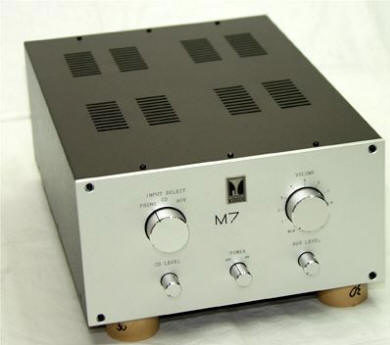
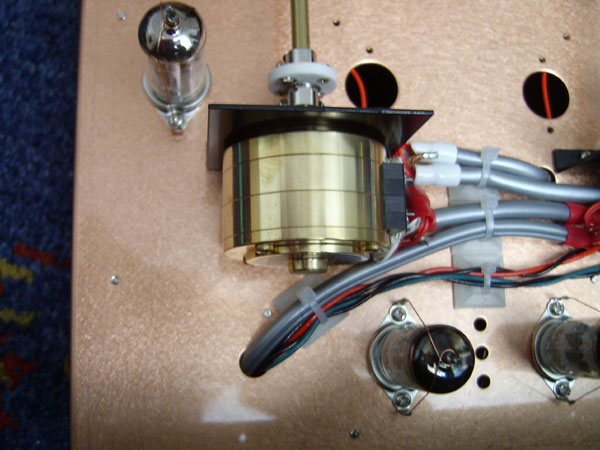
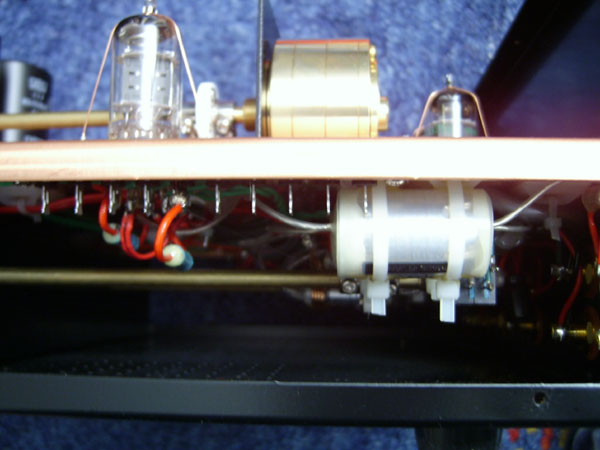
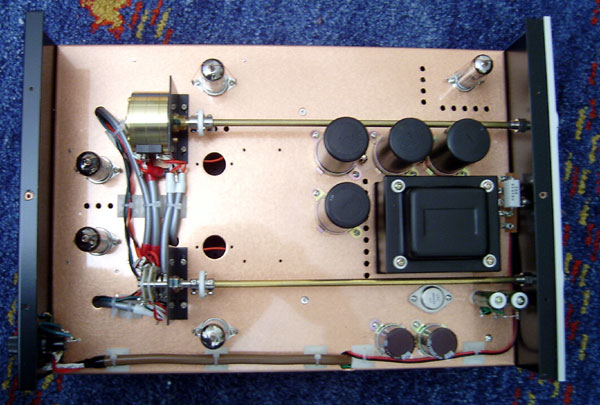
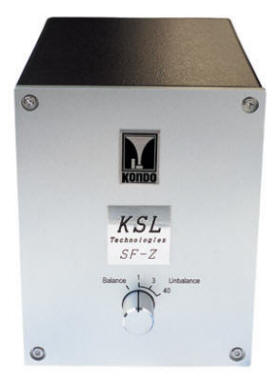
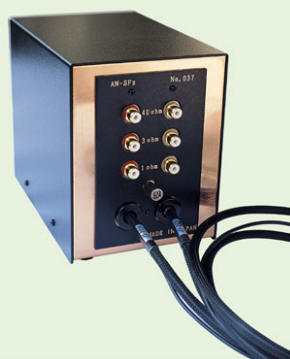
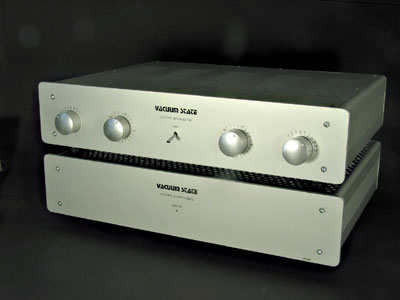

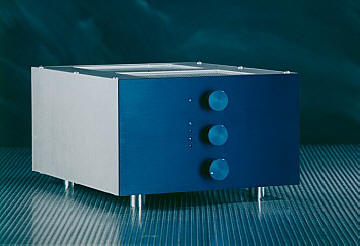
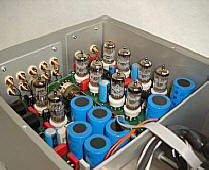
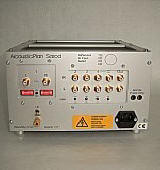
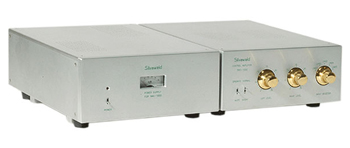 What about my reference
Silvaweld preamp? Well, to my surprise it was not in any way embarrassed by
these other giants. Dynamically, it comes within a hair of the Vacuum State,
and tonally it is within spitting distance of the Kondo. It lacks the
tiniest bit of see-through transparency, with which the Vacuum State is
creating that palpable third dimension of Jordan's guitar and amp. The net
result is not perfection in any one area, but overall excellence. In many
ways the Silvaweld is the best balanced of the four preamps tested.
What about my reference
Silvaweld preamp? Well, to my surprise it was not in any way embarrassed by
these other giants. Dynamically, it comes within a hair of the Vacuum State,
and tonally it is within spitting distance of the Kondo. It lacks the
tiniest bit of see-through transparency, with which the Vacuum State is
creating that palpable third dimension of Jordan's guitar and amp. The net
result is not perfection in any one area, but overall excellence. In many
ways the Silvaweld is the best balanced of the four preamps tested.